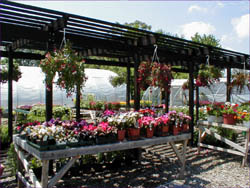

Living Plants Winning The Battle For Clean Air! Indoor air contaminants from seemingly benign sources such as furniture, drapes, carpets, insulation, paint and office machines can cause a variety of symptoms that include resiratory irratation, dizziness, headaches, skin rashes nausua and vomiting. In fact, the EPA has issued a report stating that indoor air pollution may pose serious acute and chronic health risks with an economic impact of tens of billions of dollars per year. The GOOD NEWS for homeowners and office workers: A low-cost, attractive solution does exist. Research conducted by the National Aeronautics and Space Administration (NASA) show that you may clean the air you breathe just by placing live plants throughout your home and office. NASA"s studies concluded that common indoor plants can dramatically reduce toxic chemical levels in the buildings with poor veentalation. NASA recommends placing 15 to 18 plants in an 1,800 sq. ft. home to clean and refresh the air. Maximize effectiveess by placing plants where air circulates and keep plants fresh and healthy. Natural Air Pollution Fighters Plants which provided effective as natural pollution fighters included those available at most florists of gardencenters. Orchids, Bromeliads, Gerbers Daisy, Bamboo Palm, Spider Plant, Poinsettia, Azalea, Dieffenbachia, Dracaena Marginata, Mass Cane, Spathiphyllum, Janet Craig and English Ivy lead the field in effeccttively reducing levels of a number of noxious gases found in almost every home and office building. Plants have been found effective in reducing the levels of common toxins such as benzene, formaldehyde and trichloroethylene(TCE). Benzene is a common chemical found in many products including gasoline, inks, oils, paints, plastics and rubbre. It is an additive in detergents, explosives, pharmaceuticals and dyes and has long been known as a skin and eye irritant. Formaldehyde is found in virtually all indoor environments, including foam insulation, particle board or pressed wood products. It is used in consumer paper products treated with resins, including grocery bags, waxed papers, facial tissues and paper towels. Most household cleaning agents contain formaldehyde. The EPA recently conducteeed research which shows that formaldehyde, which is an irratant to mucous membranesof the eyes, nose, and throat, may cause a rare throat cancer in long-term occupants of mobile homes. TCE is used in metal degreasing and dry-cleaning processes. It is an ingrediaent in printing inks, paints, lacquers, varnishes and adhesives. The National Cancer Society considers TCE a poent liver carcinogen. |
 If members of your family frequently suffer from sore throats and stuffy noses, they may be reacting to something more serious than allergies or the common cold.
If members of your family frequently suffer from sore throats and stuffy noses, they may be reacting to something more serious than allergies or the common cold. House Plants Improve The Air
House Plants Improve The Air Harmful Toxins Absorbed By Plants
Harmful Toxins Absorbed By Plants